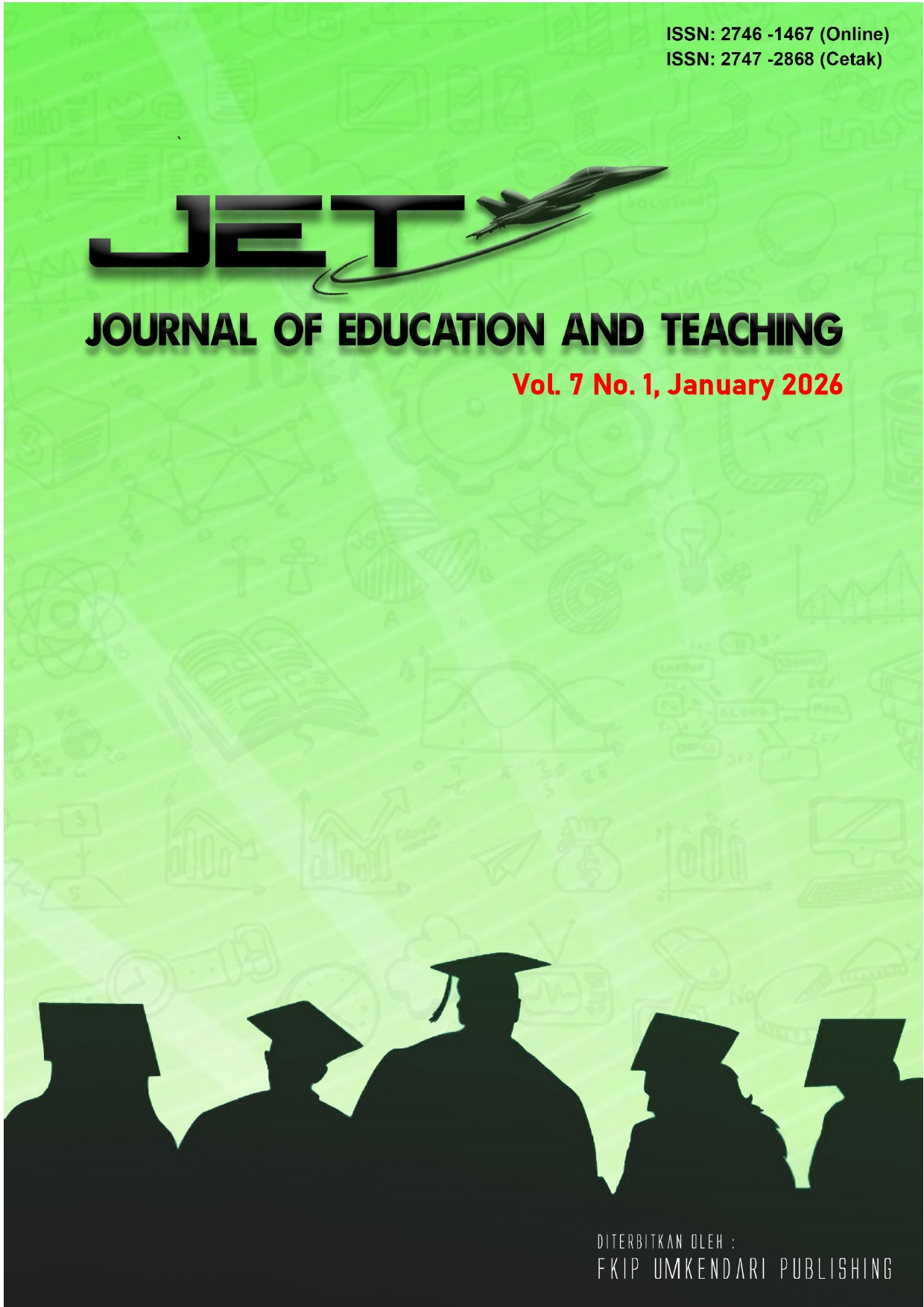Designing the Behavioral Engagement Ecosystem in Project-Based Learning
DOI:
https://doi.org/10.51454/jet.v7i1.745Keywords:
behavioral engagement, motivation, project-based learning, self-determination theoryAbstract
The study examines how specific design features of Project-Based Learning (PBL) shape and sustain behavioral engagement among young learners, addressing a gap in research that has largely focused on PBL’s effectiveness rather than the factors that drive active participation, effort, and persistence. Semi-structured interviews with elementary teachers were analyzed through the lens of Self-Determination Theory (SDT), revealing three interrelated factors critical to engagement: (1) voice, choice, and ownership, which nurture autonomy; (2) clear pathways to mastery, facilitated through scaffolding and feedback, which build competence; and (3) meaningful social connections, fostered through collaboration and teacher support, which satisfy relatedness. These findings informed the development of the Triadic Model of Behavioral Engagement in PBL, positioning autonomy, competence, and relatedness as interdependent drivers of sustained behavioral engagement. Teachers reported that these factors operate synergistically, forming a motivational ecosystem in which engagement and learning outcomes reinforce each other, producing sustained effort, participation, and ownership. Challenges such as initial student confusion and the need for ongoing scaffolding highlight the importance of responsive and flexible teaching.
Downloads
References
Aldabbus, S. (2018). Project-based learning: Implementation & challenges. International journal of education, learning and development, 6(3), 71-79.
Bell, S. (2010). Project-based learning for the 21st century: Skills for the future. The Clearing House: A Journal of Educational Strategies, Issues and Ideas, 83(2), 39-43. https://doi.org/10.1080/00098650903505415
Blumenfeld, P. C., Kempler, T. M., & Krajcik, J. S. (2006). Motivation and cognitive engagement in learning environments (pp. 475-488). na.
Blumenfeld, P. C., Soloway, E., Marx, R. W., Krajcik, J. S., Guzdial, M., & Palincsar, A. (1991). Motivating project-based learning: Sustaining the doing, supporting the learning. Educational Psychologist, 26(3-4), 369-398. https://doi.org/10.1080/00461520.1991.9653139
Cole, F. (2024). An educator's guide to project-based learning: turning theory into practice. Routledge. https://doi.org/10.4324/9781003424345
Condliffe, B. (2017). Project-Based Learning: A Literature Review. Working Paper. MDRC.
Deci, E. L., & Ryan, R. M. (2013). Intrinsic motivation and self-determination in human behavior. Springer Science & Business Media.
Deci, E. L., & Ryan, R. M. (2000). The "what" and "why" of goal pursuits: Human needs and the self-determination of behavior. Psychological Inquiry, 11(4), 227–268. https://doi.org/10.1207/S15327965PLI1104_01
De Oliveira, L. C., & Jones, L. (2023). Teaching young multilingual learners: Key issues and new insights. Cambridge University Press. https://doi.org/10.1017/9781108934138[Opens in a new window]
EDCOM II. (2025). Fixing the Foundations: A Matter of National Survival. Second Congressional Commission on Education. https://edcom2.gov.ph/publications/year2report/
Early, D. M., Maxwell, K. L., Burchinal, M., Alva, S., Bender, R. H., Bryant, D., ... & Zill, N. (2007). Teachers' education, classroom quality, and young children's academic skills: Results from seven studies of preschool programs. Child development, 78(2), 558-580. https://doi.org/10.1111/j.1467-8624.2007.01014.x
Evans, M., & Boucher, A. R. (2015). Optimizing the power of choice: Supporting student autonomy to foster motivation and engagement in learning. Mind, Brain, and Education, 9(2), 87-91. https://doi.org/10.1111/mbe.12073
Ferrero, M., Vadillo, M. A., & León, S. P. (2021). Is project-based learning effective among kindergarten and elementary students? A systematic review. PloS one, 16(4), e0249627. https://doi.org/10.1371/journal.pone.0249627
Fredricks, J. A. (2011). Engagement in school and out-of-school contexts: A multidimensional view of engagement. Theory into practice, 50(4), 327-335. https://doi.org/10.1080/00405841.2011.607401
Fredricks, J. A., Blumenfeld, P. C., & Paris, A. H. (2004). School engagement: Potential of the concept, state of the evidence. Review of Educational Research, 74(1), 59–109. https://doi.org/10.3102/00346543074001059
Gradient Learning. (2023). The kids are not alright: Student engagement is a major concern, survey finds. PR Newswire. https://www.prnewswire.com/news-releases/the-kids-are-not-alright-student-engagement-is-a-major-concern-survey-finds-301722547.html
Johnson, C. S., & Delawsky, S. (2013). Project-based learning and student engagement. Academic research international, 4(4), 560.
Kirschner, P. A., Sweller, J., & Clark, R. E. (2006). Why minimal guidance during instruction does not work: An analysis of the failure of constructivist, discovery, problem-based, experiential, and inquiry-based teaching. Educational Psychologist, 41(2), 75–86
Ladd, G. W., Birch, S. H., & Buhs, E. S. (1999). Children's social and scholastic lives in kindergarten: Related spheres of influence?. Child development, 70(6), 1373-1400. https://doi.org/10.1111/1467-8624.00101
Larmer, J., Mergendoller, J., & Boss, S. (2015a). Gold Standard PBL: Essential Project Design Elements.
https://www.pblworks.org/blog/gold-standard-pbl-essential-project-design-elements
Maher, D. & Yoo, J. (2017). Project-Based Learning in the Primary School Classroom. Nova Science Publishers.
Patall, E. A. (2013). Constructing motivation through choice, interest, and interestingness. Journal of Educational Psychology, 105(2), 522. https://psycnet.apa.org/doi/10.1037/a0030307
Piaget, J. (1972). Development and learning. Reading in child behavior and development, 38-46.
Provenzano, N. (2018). Encouraging student voice with project-based learning. ASCD Inservice. https://www.ascd.org/blogs/encouraging-student-voice-with-project-based-learning
Steele, A. (2019, June 25). What is active learning and what are the benefits? Cambridge University Press. Retrieved from https://www.cambridge.org/bw/education/blog/2019/06/25/what-active-learning-and-what-are-benefits
Reeve, J. (2012). A Self-determination Theory Perspective on Student Engagement. In: Christenson, S., Reschly, A., Wylie, C. (eds) Handbook of Research on Student Engagement. Springer, Boston, MA. https://doi.org/10.1007/978-1-4614-2018-7_7
Skinner, E.A., Pitzer, J.R. (2012). Developmental Dynamics of Student Engagement, Coping, and Everyday Resilience. In: Christenson, S., Reschly, A., Wylie, C. (eds) Handbook of Research on Student Engagement. Springer, Boston, MA. https://doi.org/10.1007/978-1-4614-2018-7_2
Sweller, J., Ayres, P., Kalyuga, S. (2011). Altering Element Interactivity and Intrinsic Cognitive load. In: Cognitive Load Theory. Explorations in the Learning Sciences, Instructional Systems and Performance Technologies, vol 1. Springer, New York, NY. https://doi.org/10.1007/978-1-4419-8126-4_16
Thomas, J. W. (2000). A review of research on project-based learning.
Valenzuela, J. (2024). Project-Based Learning:Enhancing Academic, Social, and Emotional Learning. Sage Publications Ltd.
Wong, Z. Y., Liem, G. A. D., Chan, M., & Datu, J. A. D. (2024). Student engagement and its association with academic achievement and subjective well-being: A systematic review and meta-analysis. Journal of Educational Psychology, 116(1), 48. https://psycnet.apa.org/doi/10.1037/edu0000833
Van Gog, T., Paas, F., & Van Merriënboer, J. J. (2006). Effects of process-oriented worked examples on troubleshooting transfer performance. Learning and Instruction, 16(2), 154-164. https://doi.org/10.1016/j.learninstruc.2006.02.003
Downloads
Published
How to Cite
Issue
Section
License
Copyright (c) 2025 Maria Coney Garcia Pallones

This work is licensed under a Creative Commons Attribution-ShareAlike 4.0 International License.




